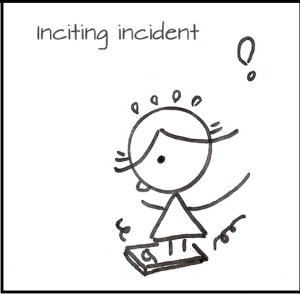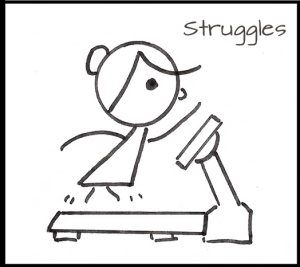Long time readers know I am completely obsessed with story architecture, and use it in many things: writing (of course), presentations and even product design. I have a version of the story that is particularly useful when trying to design a meaningful product customers will love and adopt. I think of it as putting the story back into storyboards!
 Panel 1: A character and a motivation.
Panel 1: A character and a motivation.
The character is the customer or user of the product you are making.
What is the difference between goal and motivation? The goal is what they want to do, the motivation is why. Knowing the motivation can help you see the bigger picture, and can lead to more complete or innovative solutions.
When I teach this, I usually say, “I’ve been meaning to lose weight for while, because I love my daughter and hope to dance at her wedding some day.”
Your product can now focus on weight loss, or it can help the protagonist live a healthier life.
You can also include setting– where the protagonist deals with this challenge, in order to better understand the environment in which your customer experiences her challenges and makes her decisions.
Other examples:
Goal: Track Steps. Motivation: wants to exercise. Wants to brag. Curiosity about how much she travels.
Goal: Find a taxi. Motivation: wants to get across town for an important job interview. Got lost in bad part of town, and needs to get home.
Make the motivation something universal, that anyone on your team can relate to, in order to create empathy.
Panel 2: Inciting incident
We all have goals and motivations, but what finally prompts you to try to solve this challenge?
In the story, I say “I’ve been meaning to try to lose weight for some time, yet months go by and I don’t start down that path.” Sound familiar? Even though weight loss is very important to me, I can’t get started.
But there are many things that might get me to change. A new number on the scale I never saw before. A relative who get diabetes. Can’t wear my favorite jeans…
This is important, because if you know what motivates your customers to take action, you can capture that commitment to change and get them to consider your product or service. You might even understand where to message your product.
Panel 3 is Struggles
How has your customer already tried to solve this problem?
What are they trying to use now?
Either competitors, or their own home-grown solutions.
Why don’t those work?
You can expand this to multiple panels in an 8-panel format, covering more things your protagonist has tried.

Panel 4 is the “Black Moment” or Crises.
This is the moment in the story where all is lost. The customer believes she will never solve her problem, and things are getting worse and worse.
The doctor tells our protagonist her weight is going up, and so is her blood sugar, blood pressures…her health is in danger! She has to solve this problem!
Stakes are a key idea in story. It’s what it costs the protagonist if they don’t solve reach the goal set in panel one. This is a great place to show the stakes, or raise them.
 Panel 5: Product to the rescue!
Panel 5: Product to the rescue!
Your character discovers your product.
Here we see the fabulous delivered diet food that will please any gourmand’s taste buds. Or something like that.
You can make it more specific and show how the protagonist finds it. A commercial, a billboard, a friend or doctor recommending it…
Placing the product into the climax was inspired by Kendall Haven‘s research on the biology of story. Our hero’s discovery of the product at the turning point gives the protagonist agency while still placing the product in context of her life.
This panel should speak to the struggles earlier. Why is your solution better?

And finally, taking a page from the hero’s journey, show how your customer’s life is better.
Panel 6: Change
How has the customer changed?
Are they happy now?
Productive?
Glamorous?
Thin?
Alive?
This simple story places your product (or service) in context of a real problem and a person’s hopes and dreams. With a little thought, you can make sure you are making something that really will help.
In the workshops on innovation I run, we show this cartoon to potential customers, in order to familiarize with the product promise before doing participatory roadmap exercises. It provides context for people as they prioritize features.
I was chatting with a consultant friend today, and she now shows it before running product prototype tests. The cartoon helps get people in the right mindset to evaluate solutions.
You can also use this to validate if you are solving the right problem. Walk a customer through this, and ask them to mark where their situation is different, and where it is the same.
I highly recommend Cartooning: Philosophy and Practice by Ivan Brunetti if you enjoy the highly geometric style I used in this story board, or just want to get better at cartooning.
I also recommend checking out my post, The Shape of Story, to get ideas for other elements of story you can use.
More on using Story to drive product decisions: The User’s Journey: Storymapping Products That People Love by Donna Lichaw
Below is the complete comic.


